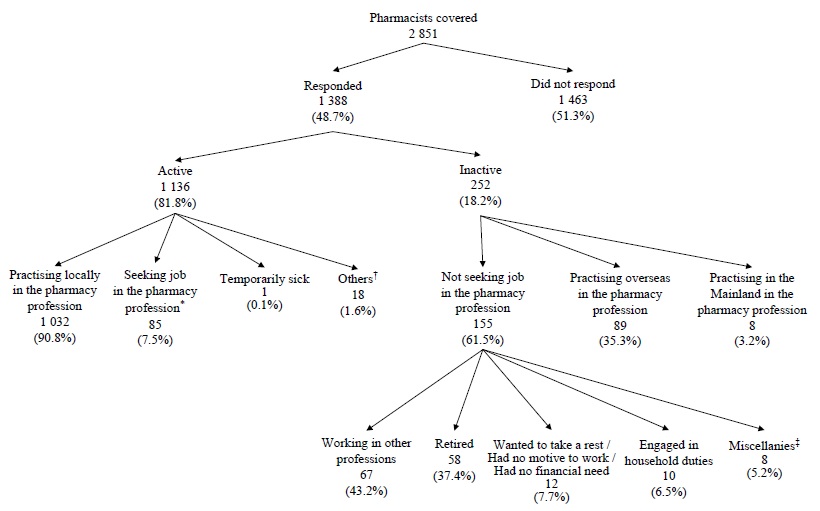Statistics
2018 Health Manpower Survey on Pharmacists
Key Findings
1 The pharmacists covered in the 2018 Health Manpower Survey of Pharmacists (HMS-PHARM) were pharmacists registered with the Pharmacy and Poisons Board of Hong Kong under the Pharmacy and Poisons Ordinance (Chapter 138) as at the survey reference date of 31 August 2018.
2 The number of pharmacists covered was 2 851.
3 Of the 2 851 pharmacists covered, 1 388 responded to the HMS-PHARM, giving an overall response rate of 48.7%. Among the respondents, 1 136 (81.8%) were economically active*† (active) in the local pharmacy profession and 252 (18.2%) were economically inactive*‡ (inactive) in the local pharmacy profession (See Chart).
4 Of the 1 136 active pharmacists enumerated, 1 032 (90.8%) were practising in the local pharmacy profession, 85(7.5%) were seeking jobs, 18 (1.6%) believed that work was not available, were waiting to take up a new job in the local pharmacy profession or starting business in pharmacy profession at subsequent date, and one (0.1%) had not been available for work because of temporary sickness during the 30 days before the survey.
5 The survey results presented below were based on the 1 032 responding pharmacists who were practising in the local pharmacy profession as at 31 August 2018. The percentages presented below may not add up to 100% due to missing responses or rounding.
(i) Four active pharmacists did not indicate their gender. Among the remaining 1 028 active pharmacists enumerated who were practising in the local pharmacy profession, 485 (47.2%) were male and 543 (52.8%) were female, giving an overall sex ratio (males per 100 females) of 89. Apart from seven pharmacists who did not indicate their age, the median age of the remaining 1 025 active pharmacists enumerated was 39.0 years.
(ii) Distribution by sector of the main jobs§ of those enumerated showed that 580 (56.2%) active pharmacists enumerated were working in the private sector, followed by 316 (30.6%) in the Hospital Authority, 99 (9.6%) in the Government and 37 (3.6%) in the academic and subvented sectors.
(iii) Of the 1 032 active pharmacists enumerated, 718 (69.6%) spent most of their working time on service in pharmacy║, followed by 135(13.1%) on administration / management¶ and 90(8.7%) on manufacturing / marketing / sales**.
(iv) The median number of hours of work (excluding meal breaks) per week of the 1 032 active pharmacists enumerated was 43.0 hours. Among them, 110 (10.7%) were required to undertake on-call duty (excluding normal duty), with a median of 8.0 hours of on-call duty (excluding normal duty) per week.
6 Among the 252 inactive pharmacists(See Chart):
(i) 155 (61.5%) reported not seeking jobs in the pharmacy profession during the 30 days before the survey. Among the 155 inactive pharmacists who reported not practising in Hong Kong and not seeking jobs in the local pharmacy profession, the main reasons reported not seeking jobs included: 67 (43.2%) were working in other professions, 58 (37.4%) were retired, 12 (7.7%) wanted to take a rest / had no motive to work / had no financial need, and ten (6.5%) were engaged in household duties.
(ii) 89 (35.3%) reported practising overseas and eight (3.2%) reported practising in the Mainland.
| * | In the survey, the criteria used in defining economically active / inactive followed those recommended by the International Labour Organization, which are also being used by the Census and Statistics Department in Hong Kong. |
| † | “Economically active” pharmacists comprised all “employed” and “unemployed” pharmacists. “Employed” pharmacists referred to those pharmacists practising in the pharmacy profession in Hong Kong during the survey period, while “unemployed” pharmacists referred to those pharmacists who (a) were not practising in the local pharmacy profession during the survey period; (b) had been available for work during the seven days before the survey; AND (c) had sought work in the local pharmacy profession during the 30 days before the survey. |
| ‡ | “Economically inactive” pharmacists comprised the responding pharmacists who were not practising in the pharmacy profession in Hong Kong during the survey period, but excluding those who had been on leave during the survey period and those who were economically active but “unemployed”. |
| § | Main jobs referred to the jobs in which the pharmacists had spent most of their working time. |
| ║ | Service in pharmacy referred to the work which had direct contact with patients in dispensing and patient counselling. |
| ¶ | Administration / Management referred to the work which was out of scope of pharmacy such as supervising staff, accounting, budget control, procurement of drugs, etc. |
| ** | Manufacturing / Marketing / Sales referred to the work involving in the pharmaceutical company (wholesaler) or pharmaceutical manufacturer such as manufacturing, marketing and sale. |
Activity Status of Pharmacists Covered

| Notes: | * | Figure refers to the number of responding pharmacists who (a) were not practising in the pharmacy profession in Hong Kong during the survey period; (b) had been available for work in the local pharmacy profession during the seven days before the survey; AND (c) had sought work in the local pharmacy profession during the 30 days before the survey. |
| † | Figure refers to the number of responding pharmacists who (a) were not practising in the pharmacy profession in Hong Kong during the survey period; AND (b) believed that work was not available or were waiting to take up a new job in the local pharmacy profession during the 30 days before the survey. Some of them had been available for work in the local pharmacy profession during the seven days before the survey. | |
| ‡ |
Figure refers to the number of responding pharmacists who reported emigrated, undertaking study, etc. Percentages may not add up to 100% due to rounding. |